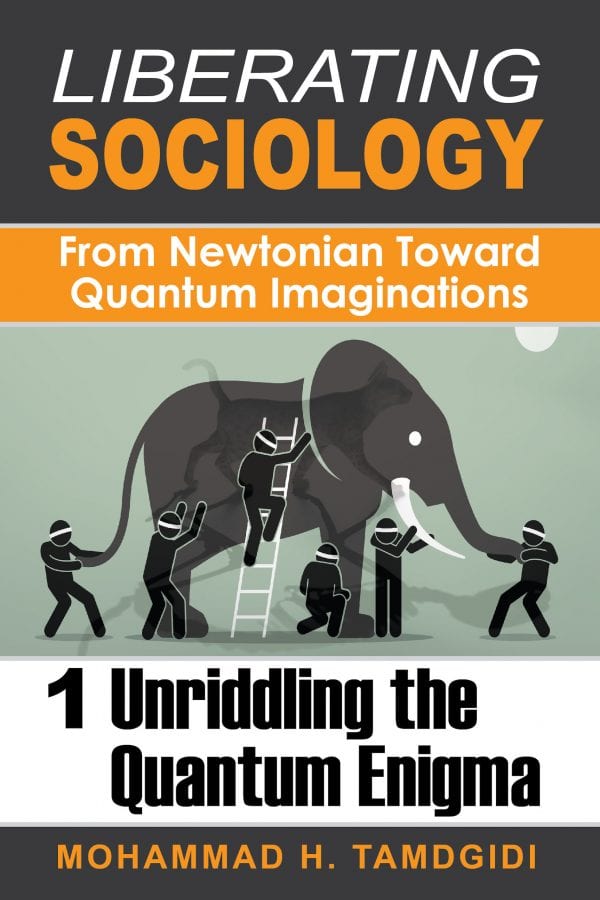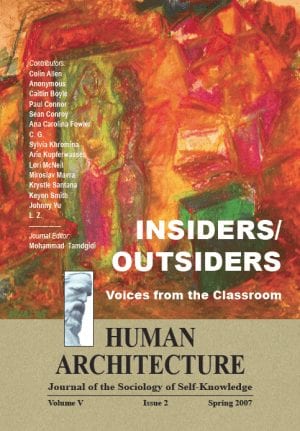Book Section: CHAPTER 8 — Describing the Elephant in the Room as a Whole: Cohering With the Many Interpretations of the Quantum Enigma — by Mohammad H. Tamdgidi
$20.00
This is the eighth chapter of the first volume of the series, Liberating Sociology: From Newtonian to Quantum Imaginations, subtitled Unriddling the Quantum Enigma, by Mohammad H. Tamdgidi. In this chapter titled “Describing the Elephant in the Room as a Whole: Cohering the Many Interpretations of the Quantum Enigma,” Tamdgidi revisits the interpretations of the quantum enigma he had introduced and surveyed in the Chapter 5 of this volume: The Incomplete Knowledge Interpretation, the Copenhagen Interpretation, the Pilot-Wave Interpretation, the Many Worlds and the Many Minds Interpretations, the Decoherence Interpretation, the Consciousness Cause Interpretation, and the Ithaca, Transactional, and Quantum Logic, Interpretations.
Description
Abstract
This is the eighth chapter of the first volume of the series, Liberating Sociology: From Newtonian to Quantum Imaginations, subtitled Unriddling the Quantum Enigma, by Mohammad H. Tamdgidi. In this chapter titled “Describing the Elephant in the Room as a Whole: Cohering the Many Interpretations of the Quantum Enigma,” Tamdgidi revisits the interpretations of the quantum enigma he had introduced and surveyed in the Chapter 5 of this volume: The Incomplete Knowledge Interpretation, the Copenhagen Interpretation, the Pilot-Wave Interpretation, the Many Worlds and the Many Minds Interpretations, the Decoherence Interpretation, the Consciousness Cause Interpretation, and the Ithaca, Transactional, and Quantum Logic, Interpretations.
Tamdgidi begins by recalling the basic findings from previous chapters that while the “two levels of reality” enigma has arisen from ways of approaching the so-called “measurement problem,” the latter—as manifested in the enigmas encountered across various experiments conducted to demonstrate and interpret the so-called quantum enigma—is itself rooted in the enigma of the “wave-particle duality of light.” Furthermore, his analysis has indicated that the still-at-core-dualistic notion “wave-particle duality of light” has itself also been a false narrative engendering yet another false “Complementarity Principle” narrative involving a need to “collapse” and “uncollapse” between a wave and a (supposedly nonwave) particle “duality” of light, a notion arising from a lack of relativistic consideration for the location of the observer when observing what otherwise is a simultaneity of localized/spread-out folds of light that always remains throughout an electromagnetic wave.
Tamdgidi argues that Einstein was correct in suggesting that the quantum enigma is a result of the incomplete theorization of the quantum world. However, paradoxically, on one hand, he himself imaginally caused such incompleteness, while, on the other hand, he also conceptually provided the key for completing the theory. Einstein was correct in believing that splitting reality into a macroscopic and a microscopic world such that two completely different sets of laws would apply to them is a problematic proposition. He sought to find a way of subsuming the laws of the below to the laws of the above. Bohr, in contrast, sharply distinguished the two “levels” from one another, so much unlike one another that the difference led him to suggest that the real macroscopic world seems to arise from a microscopic world comprised of seemingly unreal, probabilistic objects. The opposition of the two viewpoints can be reconciled and cohered, however, by arguing that quantum theory offers a valid vision for both microscopic and macroscopic worlds, provided that the relativistic interpretation extends to considering them as folds of one another dependent on the reference frame location of the observer making such a distinction.
In Tamdgidi’s view, while the basic vocabulary of the Pilot-Wave Interpretation is still dualistic and ultimately fails in unriddling the enigma, it implicitly offers clues toward a successful relativistic explanation. One of the key contributions of the Pilot-Wave Interpretation has been the problematization of the “collapse” as a necessary feature of the quantum world. Since in its definition the two attributes of corpuscularity and spread-out waviness are not deemed to be complementary (as assumed in the Copenhagen Interpretation) but an interlocked feature of objects, the problem of “switching” from one to the other does not arise as an interpretive issue even in that interpretation. The object, interlocked with its pilot-wave, interacts with other objects through their pilot-waves, without having to collapse from one mode to another in terms of a problem of losing and regaining waviness. Entangled objects join to form unified, entangled pilot-waves involving more complex motion patterns. Therefore, the problem of dualism gripping the notion of pilot-wave should not prevent us from noting the contribution it makes to envisioning the universe in terms of an undivided reality, considering the macroscopic and microscopic worlds as folds of one another. It is in this sense that the Pilot-Wave Interpretation offers its way out of the problem of “collapsing” that are shared by both the (reluctant) Einsteinian and (embracing) Bohrian visions of the quantum world.
The Many Minds variation of the Many Worlds interpretation seeks to do away with the science-fictional aspects of the latter interpretation, by suggesting that reality is not a predetermined, predictable, medium in its microscopic or macroscopic folds, but can also coexist in superposed states of alternative reality visions, imaginations, and projects in the mind. In this sense, the Many Minds and the Many Worlds interpretations, when the latter is conceived as being possible as coexistential variants in the same universe we live in, can creatively cohere with one another as well and provide further conceptual frameworks for developing the relativistic interpretation as developed in this volume.
According to Tamdgidi, an important contribution of Decoherence Interpretations has been to challenge the one-sided and narrower, consciousness-only, mechanisms for what they perceived to be a “collapsing” or “decohering” process by means of which infinite possibilities become actual realities. Finding accidental, evolutionary, or natural-historical explanations for why the macroscopic world we live in has come about and taken the shape it has in the past leading to the rise of human species as an intelligent life-form, aside from the role we ourselves have subsequently and increasingly played in that process, are not irrelevant, but especially contributive, to a fuller and deeper development of our proposed relativistic perspective.
The Consciousness Cause Interpretation as found in John Archibald Wheeler both coherently contributes as well as incoherently limits our ability to explain and unriddle the so-called quantum enigma. It contributes, because consciousness does play a definite and inescapable role in any scientific activity, microscopic or macroscopic, such that it is always participatory in terms of how the observing subject must include himself or herself in the experiment being conducted. It is limiting, in the sense that such a role by consciousness comes at times with the muddy bathwater of dualistic thinking, during which the relativistic considerations for understanding the so-called “wave-particle duality of light” are ignored, and objects are split into separable chunks that then call for fantastic explanations that at times invite spooky solutions.
Aside from the apparent dualism in the way he wishes to advance both a Monist and an Idealist interpretation of the quantum enigma, Amit Goswami’s key contribution to the Consciousness Cause conversations on the quantum enigma, as part of his bringing in the Eastern traditions into that conversation, is his emphasis on the role played by meditation in understanding and unriddling the quantum enigma. However, the way he goes about doing so is not without its problems, at times spent on proving propositions of spooky communication at a distance type, that, provable or not, distract from a more fruitful and undeniable way one can consider meditation to play a key part in providing the inner experiential conditions necessary for understanding and unriddling the quantum enigma.
The basic aim of the Ithaca Interpretation is to find a way of shedding light on the objective determinism that one may still attribute to what is usually regarded as a microscopic quantum world of infinite possibilities. Tamdgidi argues that the aim and contributions of the effort undertaken by the Ithaca Interpretation can be fruitful for the relativistic interpretation as introduced in this volume, since the latter does not necessarily rule out the possibility that there is some pre-cognitive order among apparent chaos in reality, microscopic or macroscopic.
The relativistic interpretation does not require human consciousness for the alleged collapsing requirement of objects since the collapse itself is regarded as a conceptual error arising from the “dualistic,” behaviorally separable, notion of objects being considered as either corpuscular or spread-out. According to the Transactional Interpretation, the wave function should not be regarded as only a temporally forward-moving function but one that depends on and allows for reverse motion, since the process of the so-called “collapse” is not a one-way street, so to speak, but a transactional, two-way street. Bringing the Ithaca and Transactional interpretations into one another’s fold requires a rethinking and reimagining of the very logical tools we use to understand reality. And this is why Tamdgidi also included the Quantum Logic Interpretation as another important interpretive contribution toward describing our elephant in the room.
What appears to us dualistically as atomistic, separable, subjectlessly “objective,” deterministic, locally continuous, and knowable only through disciplinarity and ethnocentric scientism are so manifested falsely because they are frozen, falsely universalized, cross-sectional expressions in longer-term, larger-scale manner in our own reference frame of a fuller process that is much more rapidly enacted in microscopic world—characterized by simultaneity, superpositionality, inseparability, relativity (subject-included objectivity), probability, and transcontinuity, understandable through transdisciplinary and transcultural points of view, best described in terms of the nonreductive dialectics of wholes and parts involving a simultaneity, of unity in diversity, of identity and difference of opposites. Quantum world appears “Quantum Newtonian” (what Tamdgidi coins as a completely relativistic, quantum science-accommodating Newtonianism) in the reference frame of any observer, whether or not he or she goes up or down the escalator of reference frames. Completely relativistic Newtonianism or Quantum Newtonianism is a seemingly slowed down and larger scale expression of the quantum world in one’s own reference frame.
Recommended Citation
Tamdgidi, Mohammad H. 2020. “CHAPTER 8 — Describing the Elephant in the Room as a Whole: Cohering With the Many Interpretations of the Quantum Enigma.” Pp. 473-554 in Liberating Sociology: From Newtonian Toward Quantum Imaginations: Volume 1: Unriddling the Quantum Enigma. (Human Architecture: Journal of the Sociology of Self-Knowledge: Vol. XIII, Issue 1, 2020.) Belmont, MA: Okcir Press (an imprint of Ahead Publishing House).
The various editions of the volume of which this chapter is a part can be ordered from the Okcir Store and all major online bookstores worldwide (such as Amazon, Barnes&Noble, and others).
Read the Above Publication Online
To read the above publication online, you need to be logged in as an OKCIR Library member with a valid access. In that case just click on the large PDF icon below to access the publication. Make sure you refresh your browser page after logging in.








